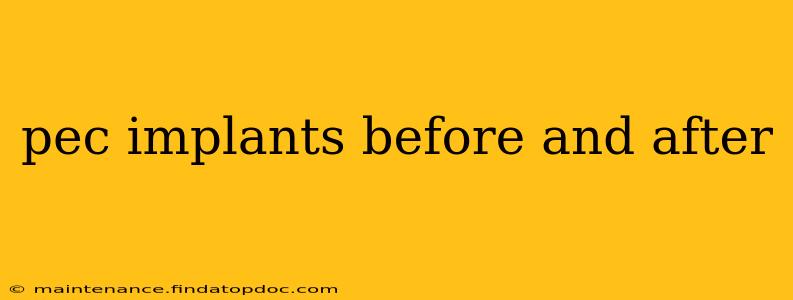Considering pectoral implants? Understanding the before-and-after process is crucial for making an informed decision. This comprehensive guide explores the entire journey, from initial consultation to post-operative recovery, addressing common questions and concerns.
What Does the Before Process Involve?
The journey begins with a thorough consultation with a qualified plastic surgeon. This isn't just about discussing your desired outcome; it's a crucial step to assess your suitability for the procedure. The surgeon will evaluate your overall health, discuss your medical history, and assess your pectoral muscle development and body composition. Realistic expectations are set, and potential risks and complications are thoroughly explained. You'll also discuss implant size, shape, and placement to achieve your aesthetic goals. Pre-operative imaging, such as photos and measurements, might be taken to document your baseline appearance.
What are the different types of pec implants?
Pectoral implants come in various shapes and sizes, each designed to achieve specific aesthetic goals. The surgeon will discuss the options available and recommend the best choice based on your individual anatomy and desired outcome. These can include different materials, such as silicone or saline, and vary in shape, from round to anatomical.
What are the risks and benefits of pec implants?
Like any surgical procedure, pectoral implants carry risks. These can include infection, bleeding, capsular contracture (scar tissue formation around the implant), implant rupture or displacement, and nerve damage. Potential benefits, however, include enhanced chest definition, improved body symmetry, and increased self-confidence. The surgeon will fully explain all risks and benefits to help you make an informed decision.
The Surgery and Immediate Post-Operative Period
The procedure itself is typically performed under general anesthesia. The surgeon creates an incision, usually in a less visible area such as under the armpit or around the nipple, to insert the implant. The implant is positioned carefully to create a natural-looking result. After the surgery, you'll likely have dressings and possibly drains in place. Pain management will be addressed, and you'll receive specific post-operative care instructions.
What is the recovery time after pec implant surgery?
Recovery varies depending on individual factors, but expect some discomfort, bruising, and swelling for several weeks. You'll need to avoid strenuous activity and follow your surgeon's instructions regarding medication, wound care, and follow-up appointments. The full recovery process can take several months.
What should I expect during the healing process?
Healing involves gradual reduction of swelling and bruising, as well as improving mobility and comfort. You'll likely have follow-up appointments to monitor healing progress and ensure everything is proceeding as expected. Patience and adherence to your surgeon’s instructions are crucial.
Pec Implants: The After Pictures and Long-Term Results
The “after” pictures you see online represent a snapshot in time. The true beauty of pectoral implants lies in the lasting enhancement they provide. While the immediate results are noticeable, the final result is fully realized only after the complete healing process.
How long do pec implants last?
Pectoral implants are designed to last for many years, but they may eventually need replacement due to capsular contracture, rupture, or simply due to changes in your body or desired aesthetic over time. Regular follow-up appointments are vital to monitor implant longevity.
What is the long-term care involved?
Long-term care involves regular checkups with your surgeon to monitor the implants and your overall health. You'll also need to maintain a healthy lifestyle, as this can positively impact the long-term results and overall wellbeing.
Conclusion
Choosing pectoral implants is a significant decision. Thorough research, realistic expectations, and a strong doctor-patient relationship are paramount. This guide provides a foundational understanding of the before-and-after process, but always seek personalized advice from a qualified plastic surgeon who can address your specific concerns and guide you throughout the journey. Remember, open communication with your surgeon is key to a successful outcome and a positive experience.
